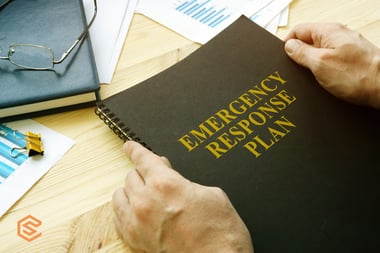
June is National Safety Month, so it’s the perfect time to examine your company's safety protocols.
With all businesses, it’s important to be prepared for any kind of emergency whether it’s a fire, health, or natural disaster. Employers should equip the workplace with appropriate alarm signals and safety measures to reduce or avoid work-related accidents and injuries in the event of an emergency.
Emergency preparedness planning can make all the difference between staying in business and losing everything. Being prepared and having a plan is one of the easiest ways to help ensure your business and your people are truly protected.
Before we get into the ins and outs of what one should do in order to prepare a business for an emergency, let’s start with the basics: what is a workplace emergency and what is an emergency action plan (EAP)?
What is a workplace emergency?
A workplace emergency is a situation that threatens workers, customers, or the public; disrupts or halts operations; or causes physical or environmental damage. Many types of emergencies can be anticipated in the planning process, which can help employers and workers plan for other unpredictable situations.
The best way to prepare for a workplace emergency is to prepare before it happens. Take the proactive and not reactive approach, because when an emergency hits, the stress hinders your ability to think clearly. Brainstorming the worst-case emergency scenarios, identifying them, and considering how they could affect employees and customers will allow a business to craft a detailed emergency action plan.
What is an Emergency Action Plan?
An emergency action plan covers designated actions employers and employees must take to ensure employee safety from fire and other emergencies. While many businesses are not required to create an EAP, doing so is a good way you can protect the business, assets, employees, and customers during an emergency.
What do I include in my Emergency Action Plan?
When developing a business’ EAP, it’s important to consider a wide range of potential emergencies and safety issues that could occur in your workplace. You need to tailor the plan to your worksite and include information about all potential sources of emergencies. If the business has more than one location, each branch should have an EAP.
At a minimum, your EAP should include the following:
- Emergency notifications for reporting fires and other emergencies
- An evacuation policy and procedure following chain of command
- Emergency evacuation route and procedures
- Contact information for responders within and outside the company to contact for additional information or explanation of duties and responsibilities under the emergency plan
- Protocols for employees who remain to perform critical office operations, operate fire extinguishers, or perform other essential services that cannot be shut down for every emergency alarm before evacuating
- Rescue and medical duties for any employees who are certified to perform them
- In the event of a fire, or any emergency, it’s important to have post-emergency/evacuation protocol in order, such as securing assets, gathering location, and an offsite communications center.
Emergency Notifications
There are a few options for an emergency notification system, including public addresses and texting networks to alert of potential threats or emergencies. Make sure that the messages efficiently reach everyone. Take particular care if some employees have disabilities or cannot speak English well or at all.
Chain of Command
An emergency notification system is only as effective as its organization. Decide who will send notifications as well as who will take the place of these workers should they be unavailable or incapacitated.
Evacuation Routes and Procedures
Once an evacuation plan has been created, it’s critical to train staff in proper procedure. A local fire department can often help facilitate evacuation training. As with emergency notification systems, ensure that employees with disabilities have appropriate aids in place.
Responder Protocols
Sometimes, certain people will need to stay behind longer than most employees in order to shut down operations. It’s important safety procedures and protocols are in place to ensure their safety.
Operating Fire Extinguishers
Fire extinguishers include instructions, but the proper employees should be trained in how to operate them, know where they’re located throughout the building, and ensure they are in the appropriate location.
Rescue and Medical Duties
For those employees certified in CPR and AED operation, the business needs to make note of those who can jump in if an emergency calls for lifesaving procedures.
Post-emergency Evacuation Plans
After the evacuation has been carried out, it’s important to have protocol in place, including a designated meeting area, securing business assets (e.g.: back-up servers), and providing an offsite communications center (e.g.: call center) in the chance the building will not be operable for some time.
None of these life safety and emergency precautions matter if you do not commit to creating safe workplace conditions and ensuring safe worker interactions. A plan and a policy can only take you so far. It’s vital to hold preparedness training, fire drills, and designate a safety committee so that there’s peace of mind that employees are ready to respond to emergencies and work-related safety issues.
You may not be able to predict every emergency, but you can prepare for them. The above list and information will help ensure the business is prepared for fire, life safety, or weather emergencies.
For more detailed information about workplace emergency and safety preparedness, visit OSHA, American Red Cross Ready Rating program, or FEMA, which provide resources and useful information for any jurisdiction or industry.



